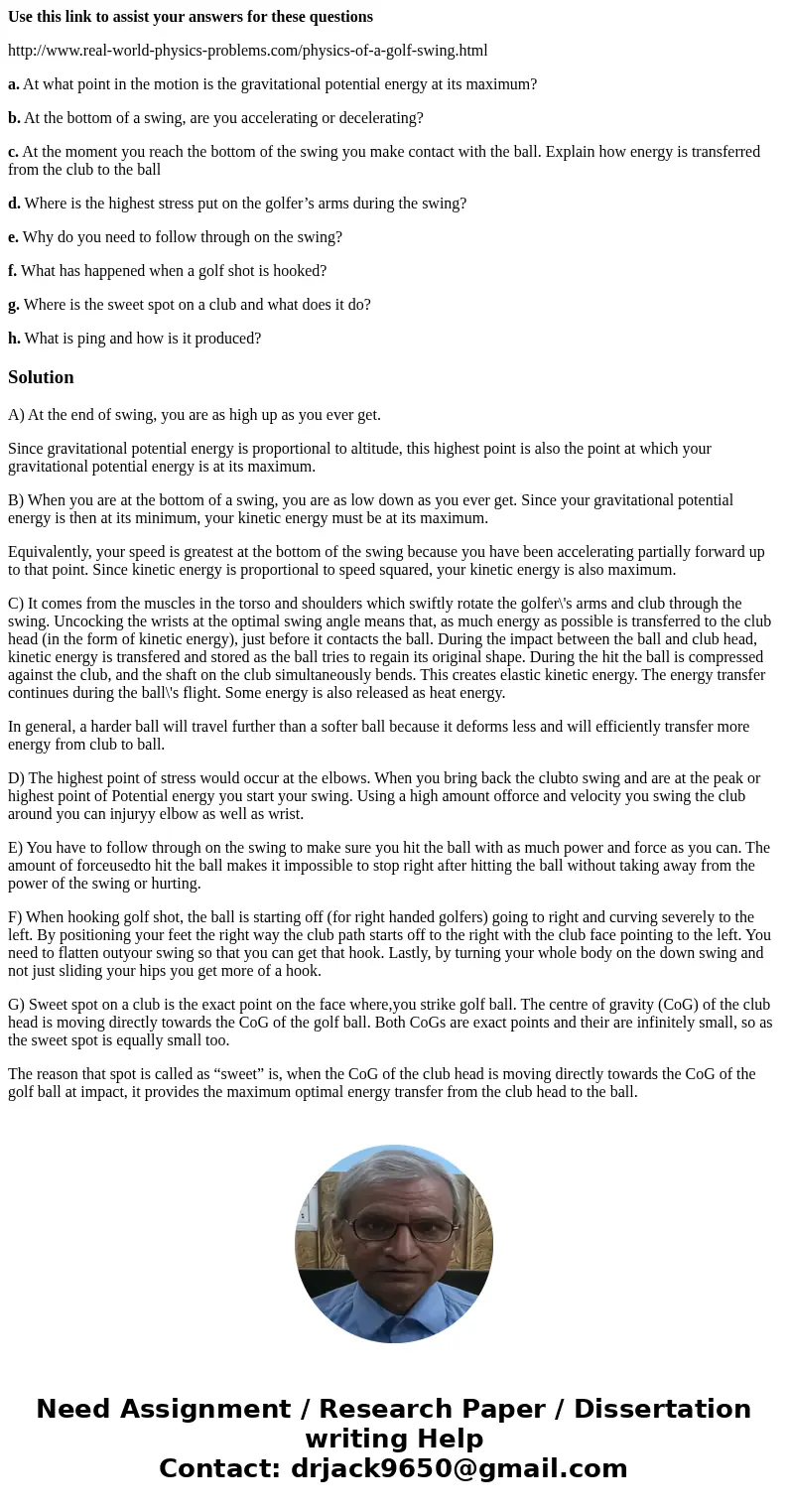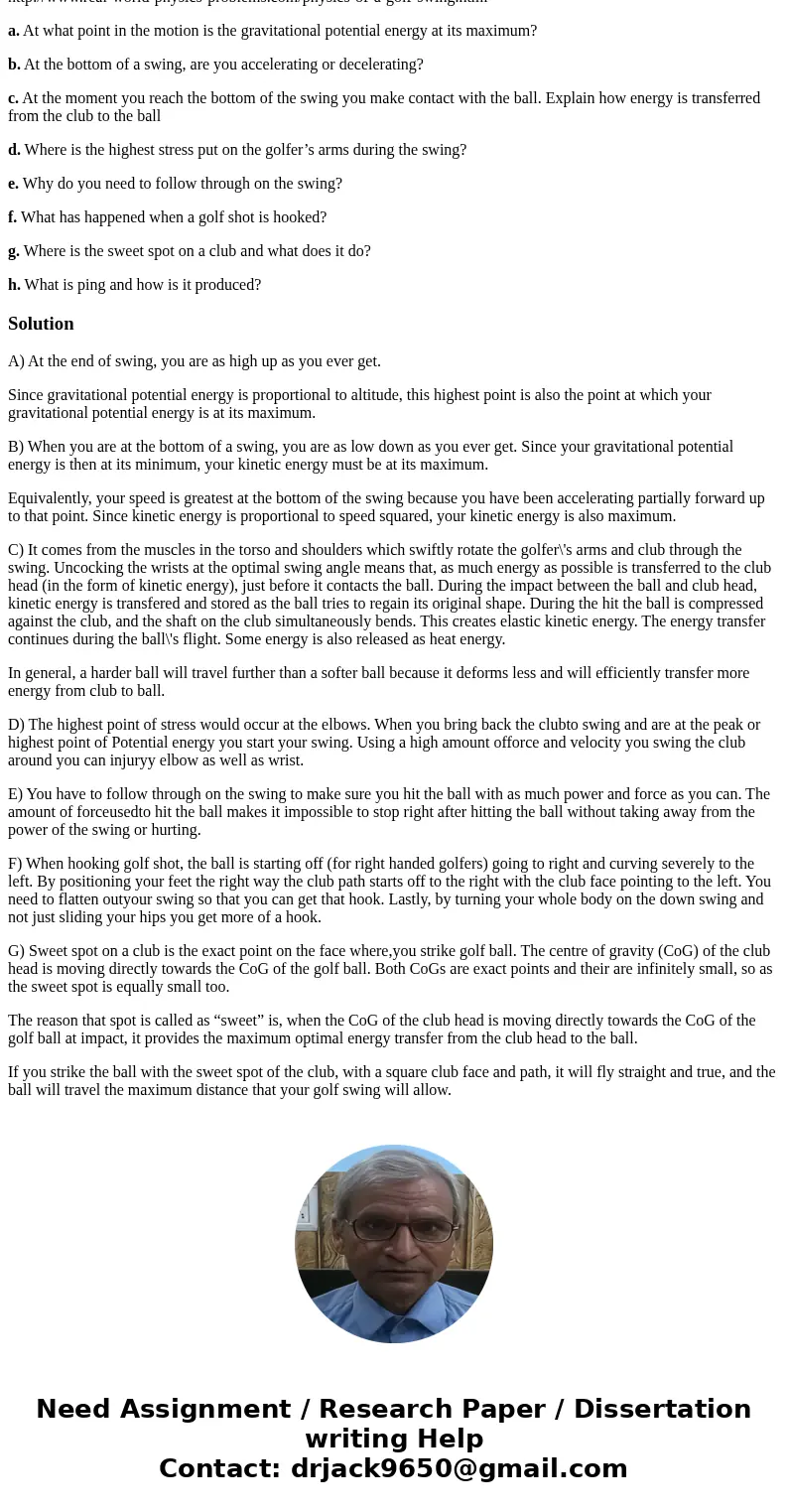Use this link to assist your answers for these questions htt
Use this link to assist your answers for these questions
http://www.real-world-physics-problems.com/physics-of-a-golf-swing.html
a. At what point in the motion is the gravitational potential energy at its maximum?
b. At the bottom of a swing, are you accelerating or decelerating?
c. At the moment you reach the bottom of the swing you make contact with the ball. Explain how energy is transferred from the club to the ball
d. Where is the highest stress put on the golfer’s arms during the swing?
e. Why do you need to follow through on the swing?
f. What has happened when a golf shot is hooked?
g. Where is the sweet spot on a club and what does it do?
h. What is ping and how is it produced?
Solution
A) At the end of swing, you are as high up as you ever get.
Since gravitational potential energy is proportional to altitude, this highest point is also the point at which your gravitational potential energy is at its maximum.
B) When you are at the bottom of a swing, you are as low down as you ever get. Since your gravitational potential energy is then at its minimum, your kinetic energy must be at its maximum.
Equivalently, your speed is greatest at the bottom of the swing because you have been accelerating partially forward up to that point. Since kinetic energy is proportional to speed squared, your kinetic energy is also maximum.
C) It comes from the muscles in the torso and shoulders which swiftly rotate the golfer\'s arms and club through the swing. Uncocking the wrists at the optimal swing angle means that, as much energy as possible is transferred to the club head (in the form of kinetic energy), just before it contacts the ball. During the impact between the ball and club head, kinetic energy is transfered and stored as the ball tries to regain its original shape. During the hit the ball is compressed against the club, and the shaft on the club simultaneously bends. This creates elastic kinetic energy. The energy transfer continues during the ball\'s flight. Some energy is also released as heat energy.
In general, a harder ball will travel further than a softer ball because it deforms less and will efficiently transfer more energy from club to ball.
D) The highest point of stress would occur at the elbows. When you bring back the clubto swing and are at the peak or highest point of Potential energy you start your swing. Using a high amount offorce and velocity you swing the club around you can injuryy elbow as well as wrist.
E) You have to follow through on the swing to make sure you hit the ball with as much power and force as you can. The amount of forceusedto hit the ball makes it impossible to stop right after hitting the ball without taking away from the power of the swing or hurting.
F) When hooking golf shot, the ball is starting off (for right handed golfers) going to right and curving severely to the left. By positioning your feet the right way the club path starts off to the right with the club face pointing to the left. You need to flatten outyour swing so that you can get that hook. Lastly, by turning your whole body on the down swing and not just sliding your hips you get more of a hook.
G) Sweet spot on a club is the exact point on the face where,you strike golf ball. The centre of gravity (CoG) of the club head is moving directly towards the CoG of the golf ball. Both CoGs are exact points and their are infinitely small, so as the sweet spot is equally small too.
The reason that spot is called as “sweet” is, when the CoG of the club head is moving directly towards the CoG of the golf ball at impact, it provides the maximum optimal energy transfer from the club head to the ball.
If you strike the ball with the sweet spot of the club, with a square club face and path, it will fly straight and true, and the ball will travel the maximum distance that your golf swing will allow.


 Homework Sourse
Homework Sourse